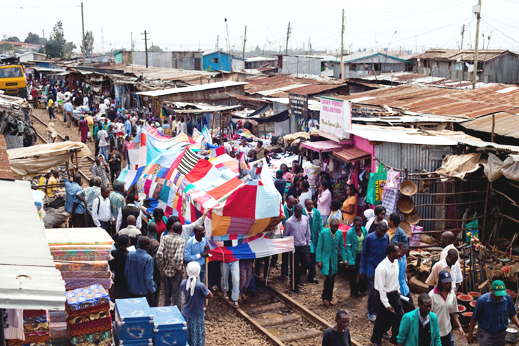 |
Overall Project in Nairobi
Photo by Yasuyoshi Chiba |
|
|
Yoshinari Nishio can sew. He is also rather adept at using the sewing machine. These simple home-keeping skills form the core of his art practice, which emerges from his long interest in fashion and clothes and today extends to participatory art projects that involve many people over several weeks.
Nishio's exhibition at A.I.T. Room in Daikanyama, Tokyo was a documentary presentation of his most recent project in Nairobi, Kenya this past January. Titled "Overall Project," the work is one of a series which he has realized since 2009. The artist researches the history and locality of a particular place and creates a life-size replica of a forgotten or faded symbol using the discarded clothes of the community. In 2009, for example, Nishio made a replica of the Ueno Great Buddha which stood for many years in Ueno Park before being melted for metal collection during World War II. His most recent project occurred in the outlying neighborhood of Kibera, Nairobi. Nishio's wife is an Africa researcher, and the couple have traveled to the continent a number of times in the past few years.
In a thirty-minute documentary video, which was the central work in the exhibition, Nishio spoke about his interest in the Jua Kali laborers who work outdoors due to the lack of studio space, welding metal or sewing fabrics on the street. We see Nishio and his assistants collecting used clothes from apartments in the city and setting up a sewing workshop on the pavement. Nishio's use of used clothes reveals the abundant volume of this commodity around the world, an everyday material which we all depend on and which increasingly flows into waste in the era of "fast fashion." However, this hyper-consumed material is also something which becomes "personalized" by the wearer, the trace of their actions and memories. Nishio's projects attempt to return or divert this waste material into something with symbolic power for a specific community.
In the case of Kibera this was a steam locomotive made out of a patchwork of used clothes. No longer in service, the steam train remains a potent symbol of Kenya's colonial period as well as of the growth of its cities. After many hours of cutting and sewing, a life-size fabric "train" was produced and paraded along a railway track in Kibera. The video shows this flimsy cloth train held aloft by dozens of people slowly moving down a track as onlookers line the route. What I found particularly intriguing in this public parade was seeing the juxtaposition of the clothes worn by people and the fabricated patchwork train. Bright colors and patterns echoed across both the "functioning" clothes and the "symbolic" used clothes, setting up a strange situation where things worn can become something totally different through simple acts such as collecting and sewing.
It is said that clothes are a second skin covering our bodies. Nishio's "Overalls" seem to suggest a third skin that emerges after clothes have fulfilled their useful function and move from the realm of individual protection to that of shared memories which are literally manifest as art objects. The Kibera locomotive rolled along the old track without the hisses and whistles of industrial power, but with the very human singing of those carrying it aloft.
|